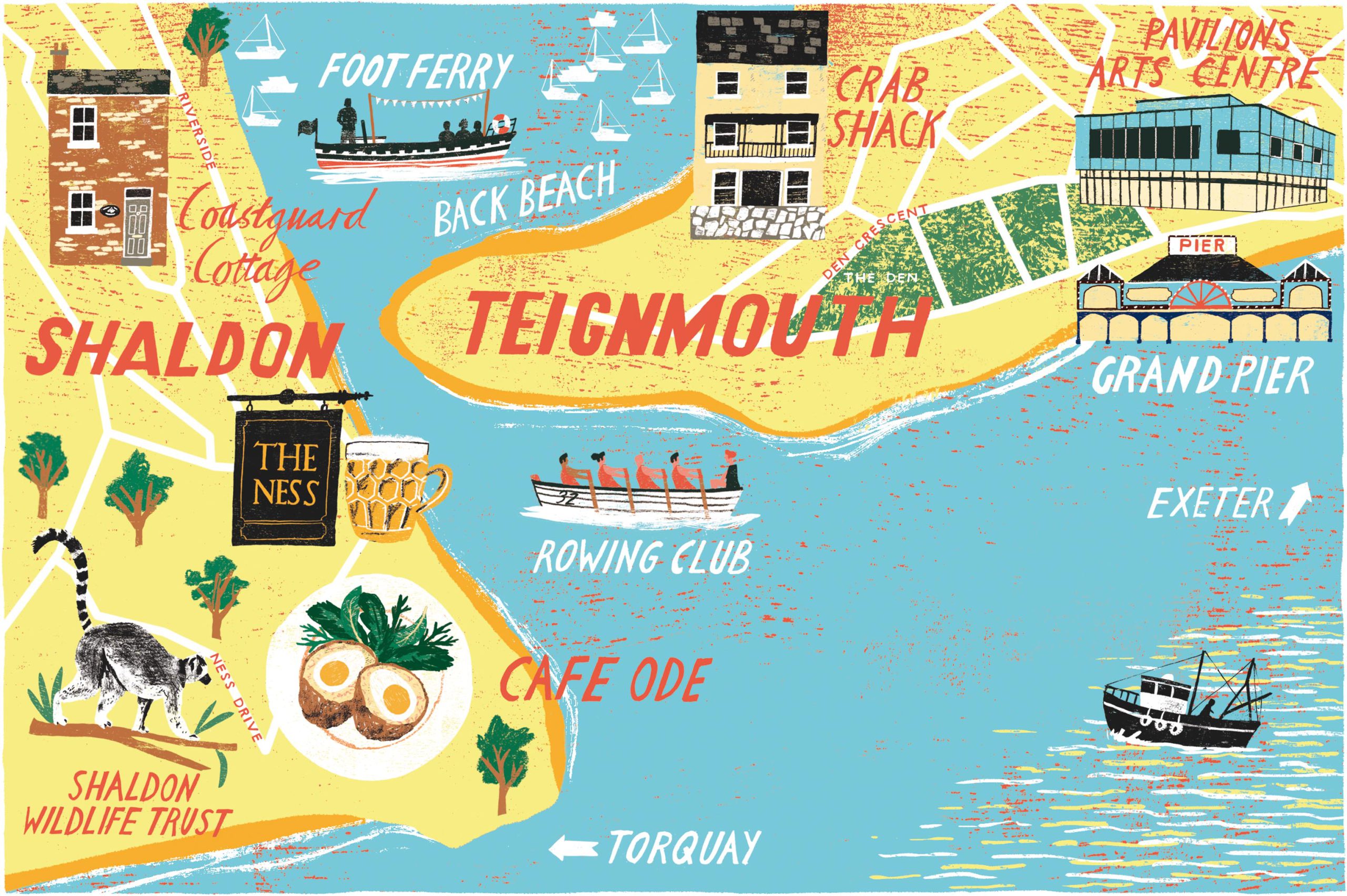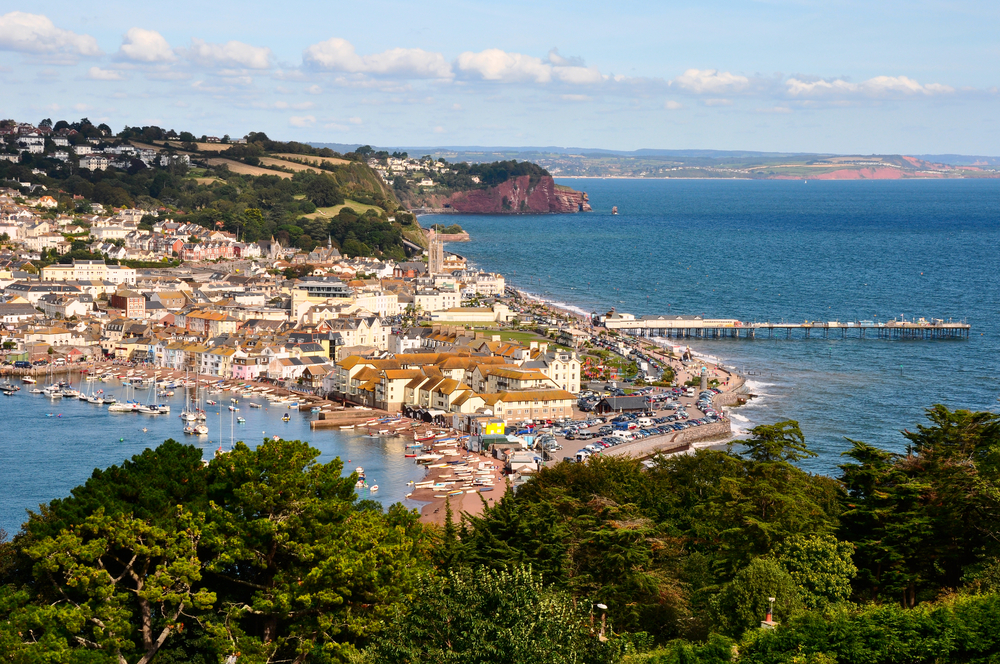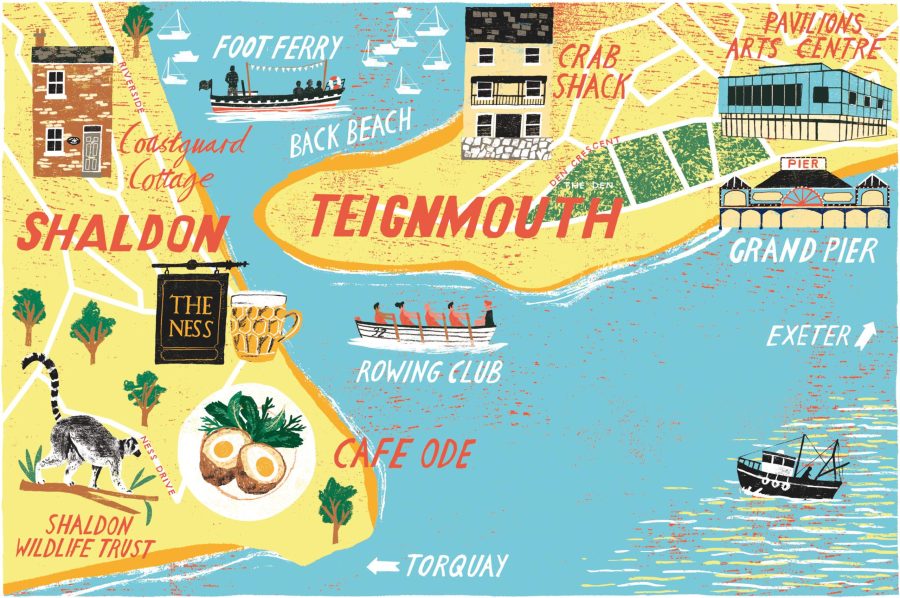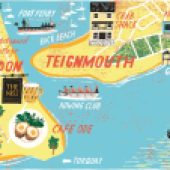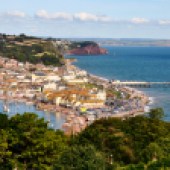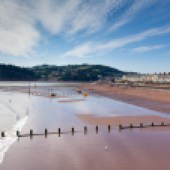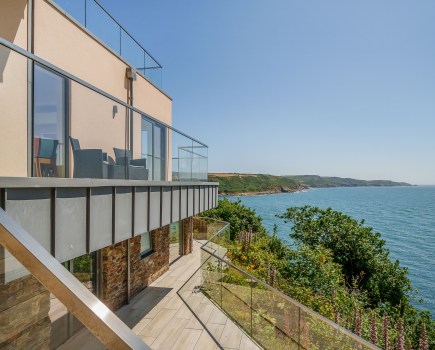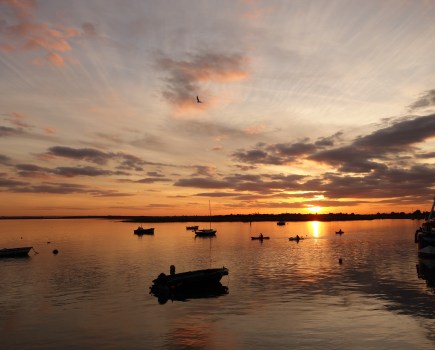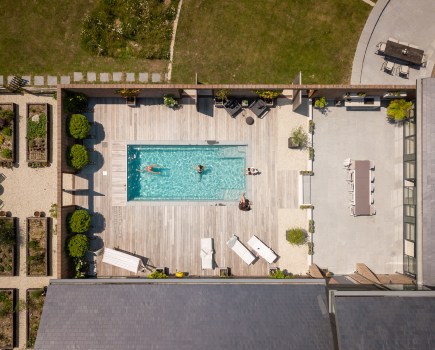A pair of twins on opposite sides of South Devon’s River Teign, Teignmouth and Shaldon offer a mix of boats, lively beaches and good-value Regency homes. Words: Lesley Gillilan Illustration: Tom Jay
Teignmouth is not as well known as its neighbouring estuary hotspots (Salcombe, Exmouth or Dartmouth). Even pronouncing the name is a challenge (it’s Tinmuth). But for those in the know, there is nowhere better. Vintage railway posters called it ‘the gem of South Devon’, and although it has suffered a period of decline, the town is on the up.
‘There’s a real charm to the place, and a real soul, too,’ says local artist-illustrator Laura Wall, a self-confessed ‘seaside addict’. ‘Of all the places I’ve lived, it’s the one that’s really grabbed me. There’s so much going on – even in the winter.’
Between Torquay and Dawlish, on the eastern edge of Dartmoor National Park, Teignmouth sits on a spur-like peninsula that tapers to a sandy bar, known locally as ‘the Salty’. There is a pier, a port, parks, a handsome Regency seafront and views across the estuary to pretty Shaldon village.
Linked by a road bridge (or a foot ferry), both places sit against a backdrop of farmland, framed by lofty sandstone cliffs, trimmed with terracotta beaches and laced with narrow streets of Georgian houses – Teignbridge (the local collective name) has been a popular holiday resort since the early 18th century. ‘There’s no end to the beautiful things that inspire me to paint,’ says Laura, whose ‘Love at the Seaside’ scenes invariably feature the area. In 2019, she opened her new art gallery in Teignmouth (
laurawall.com).
The attractions, Laura says, are the beaches, the sense of history, ‘the vibe’, the little streets that veer off the seafront, and the wide variety of independent shops and galleries. ‘It’s a very welcoming place,’ she says. ‘Brilliant for live music and the arts, and very creative. Like St Ives, there’s something about the light that draws artists.’
For Laura, the heart of the place is Back Beach, a jumble of sea-dog huts, boats and fishing nets, and gatherings of locals. ‘It’s all about children and dogs and barbecues and people playing guitars,’ she says. ‘There’s a very strong community here, and a sense that everyone wants to live life to the max.’
WHERE TO BUY
With its narrow Georgian streets, town beach and village shops, Shaldon is the hotspot and has most of the prime properties. However, average house prices in Teignmouth are almost half that of its smaller neighbour; and the views are arguably better from Teignmouth, which also hogs the evening sun. In Shaldon, hunt for cottages and fine Regency houses on Marine Parade, the Strand or the Green, or for large 1930s houses look high up on Teignmouth Road. Suburban Teignmouth is largely made up of 20th century housing (lots of post-war bungalows) but the centre and the seafront are a mix of Georgian and Victorian. Look at the streets around Northumberland Place, Den Crescent, leafy Landscore Road or the Eastcliff area.
TIME OUT
There is a River Teign Rowing Club (the local speciality is the four-oar ‘Seine’ boat), as well as facilities for kayaking, diving and windsurfing. Walkers can try the four-mile railway-coast path to Dawlish. Teignmouth has the Grand Pier, the Den – a long stretch of green space that runs along the seafront between the Salty and the Lido (with its heated outdoor pool), the Ice Factory studio theatre and the fresh-seafood Crab Shack on the Beach (
crabshackonthebeach.co.uk). Shaldon has the Wildlife Trust’s zoo (think meerkats and monkeys), botanical gardens and the award-winning ODE café and microbrewery at Ness Cove; part of a local, sustainable food enterprise, it’s run by Devon chef-entrepreneurs Tim and Clare Bouget (
odetruefood.com). Local events include September’s Taste of the Teign Festival. For more, see
visitsouthdevon.co.uk.
JOBS AND COMMUTING
With a history of fishing and ship-building, Teignmouth still has a small industrial port. Otherwise, the majority of jobs are in tourism, local services and the public sector. Devon’s capital, the city of Exeter, is within a viable commute (about 25 minutes by car or train). And Teignmouth station has a direct link to London via the mainline route between Paddington and Penzance. The journey to London takes around three and a half hours. The nearest airport is Exeter International.
SCHOOLS
The only secondary school in the area is Teignmouth Community School.
REALITY CHECK
Teignmouth looks dated and a little shabby in places, but don’t judge the town on first appearances: it is younger and livelier than it looks. Shaldon is picture perfect but parking is an issue (there is limited street parking for the smaller cottages that don’t have private spaces). In both places, swimmers and rowers should beware of the estuary’s strong rip tides.
REGENERATION
Teignmouth is on the up, partly due to a local regeneration initiative, which was the driver behind 2016’s opening of the Pavilions, a new seafront arts space and cinema. An emerging ‘arts quarter’ is re-invigorating a tired corner of the town centre. And Teignmouth has also benefitted from a £1m upgrade of the Fish Quay, designed to boost fishing and leisure industries.
Find more inspiration for moving to the coast here, or pick up a copy of the magazine.
AVERAGE HOUSE PRICES
Teignmouth: £289,020
Shaldon: £569,118
Devon: £300,007
House prices from RightMove (2021)
WHAT LAURA LIKES ABOUT… TEIGNMOUTH
The Teignmouth-Shaldon Ferry (teignmouthshaldonferry.co.uk) has been crossing the Teign since the 13th century and is thought to be one of the oldest passenger ferries in Britain.
The walk up to Smugglers Tunnel, which cuts a passage through a cliff to the ‘hidden beach’ at Shaldon’s Ness Cove. ‘Afterwards, we might stop for a drink at The Ness pub (theness.co.uk), which has beautiful views.’
Eastcliff Park (teignbridge.gov.uk) is a favourite walk for Laura and her dog, Roxy. A mix of tropical gardens, lawns, meadows, and ponds, the park looks down on Teignmouth towards Shaldon.
